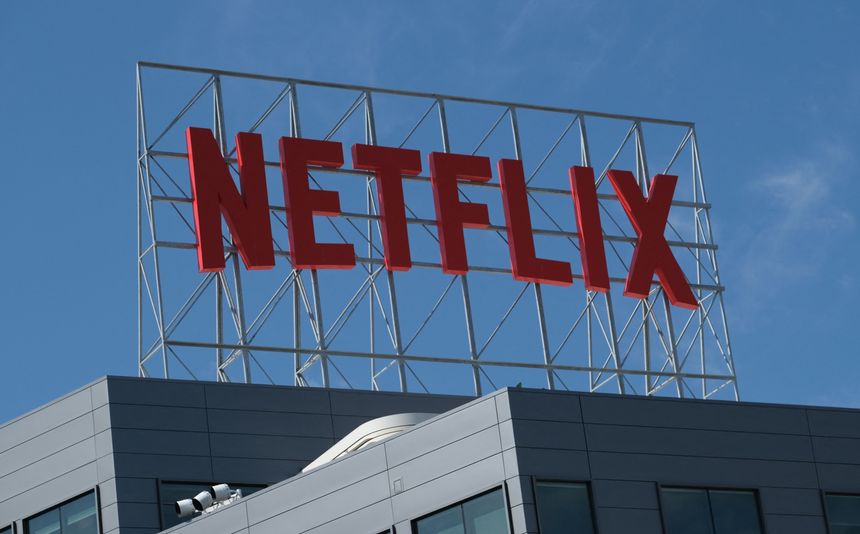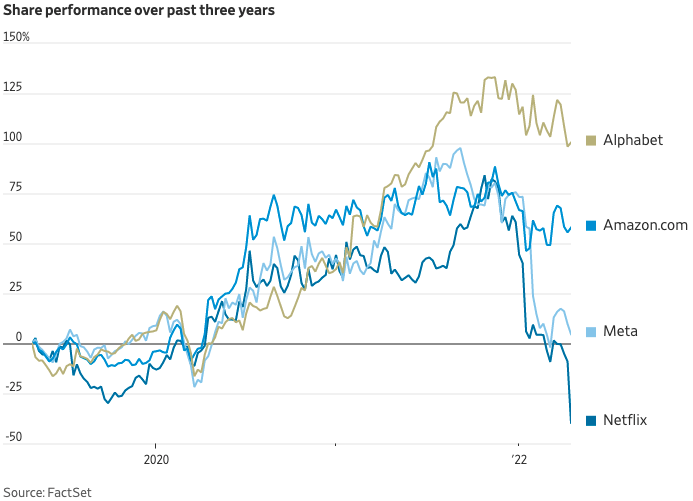Netflix Stock Price Drops 35%, Posting Biggest Fall Since 2004 – The Wall Street Journal

|
Getting your Trinity Audio player ready...
|
SOURCE: Caitlin Ostroff and Gunjan Banerji | The Wall Street Journal
Netflix Inc. shares fell 35.1% on Wednesday, recording their worst day since 2004, after the streaming giant reported that it lost subscribers in the first quarter.
William Ackman, the billionaire investor whose fund bought more than three million shares of Netflix in January, said Wednesday that the fund had sold its stake at a loss. In a letter to investors, Mr. Ackman said Netflix would reduce returns at the fund, Pershing Square, by four percentage points. That implies a loss of around $400 million.
In January, Mr. Ackman said Netflix sported an “attractive valuation”; on Wednesday he wrote, “We have lost confidence in our ability to predict the company’s future prospects.”
The shares shed more than a third of their value, finishing down $122.42 to $226.19. The stock was the S&P 500’s worst performer of the day. Investors had expected that the company would add new users in the quarter. Instead, Netflix said it ended the first three months of the year with 200,000 fewer subscribers than it had in the fourth quarter and said it expected to lose two million global subscribers in the current quarter.
Several other streaming stocks fell Wednesday. Paramount Global finished down $3.12, or 8.6%, to $33.16, and Warner Bros. Discovery Inc. was off $1.48, or 6%, to $23.01. Walt Disney Co. retreated $7.33, or 5.6%, to $124.57, while Spotify Technology SA lost $14.92, or 11%, to $122.49.
Nobody was expecting Netflix to announce they lost subscribers. They were expecting a slowdown in subscriptions, but seeing Netflix losing subscribers is a big deal.
The fall in Netflix’s shares represented its biggest single-day percentage drop since Oct. 15, 2004, when it fell 41% after saying it would cut subscription fees and postpone planned international expansion. It slashed $54.3 billion from the company’s market capitalization, its largest one-day market cap loss on record.
It is the second time the shares have tumbled this year. In January, Netflix shares slid more than 20% when the company said it expected to add a much smaller number of subscribers than it did one year prior. The stock is down 62% this year including Wednesday’s fall.
Users flocked to Netflix in the initial months of the coronavirus pandemic as lockdowns and measures to contain the virus kept people at home, sending the company’s share price to record highs. Easing of restrictions and an increase in competition from other streaming services over the past year have presented hurdles to Netflix’s growth.
“Nobody was expecting Netflix to announce they lost subscribers. They were expecting a slowdown in subscriptions, but seeing Netflix losing subscribers is a big deal,” said Ipek Ozkardeskaya, senior analyst at Swissquote Bank, an online broker.
More than 100 million Netflix shares traded hands on Wednesday, the first time it had crossed that milestone since 2015, according to Dow Jones Market Data. Some individual traders appeared to be buying the dip: The company was by far the most-purchased stock on Fidelity’s brokerage platform, according to the firm’s website. Buy orders for the stock far outpaced the number of sell orders tied to the shares.

Meanwhile, options trading volumes tied to the stock exploded on Wednesday, with around 15 times the activity seen on a typical day, according to Cboe Global Markets data. Many traders appeared to be positioning for a steeper fall in the shares, or to profit from a continued downturn. Put options that would pay out if the shares sank to $200 or $190 were among the most widely traded. Ahead of the earnings report, call options that would profit if the shares rallied were popular.
Traders shelled out around $2 billion for Netflix options as of afternoon trading, in what is known as premium, surpassing what they spent on options tied to Amazon.com Inc. or an exchange-traded fund tied to the S&P 500, according to data provider Shift Search by Vesica Technologies.
Netflix is one of the original FANG stocks, a quartet of large internet companies that reflect the dominance of technology stocks on U.S. markets. The others are Facebook -owner Meta Platforms Inc., Amazon and Google-owner Alphabet Inc. Some analysts also include Apple Inc. Cracks have emerged in the popular trade this year and analysts have said that they have reconsidered their approach to trading the technology heavyweights after some disappointing earnings.
Netflix said it is exploring offering a lower priced ad-supported version of the platform to boost its subscriber base, a shift for a company that has sold itself since its inception as a commercial-free haven for its members. The company had increased its subscription fee earlier this year.
The growing number of streaming options has made consumers more price-sensitive. Netflix is among the few major streaming services that has yet to entertain offering a cheaper, ad-supported option. Disney’s Hulu has long done so, while Warner Bros. Discovery’s HBO Max and Disney+ have also pushed into ad-supported streaming.
The step adds to investor worries that rising prices will curtail consumer spending on nonessential goods and services.

More Netflix viewers watched dubbed versions of the South Korean drama “Squid Game” than
subtitled versions. WSJ met one of the show’s English-language voice actors to see how dubbing
foreign content is fuelling the streaming giant’s growth.
“People are asking ‘Is this worth it?’” Ms. Ozkardeskaya said. “As prices rise, the worth threshold is being pulled higher and that’s pushing people to the exit.”
The company’s results also attracted the attention of Tesla Chief Executive Elon Musk, who has made a $43 billion bid to buy Twitter Inc.
“The woke mind virus is making Netflix unwatchable,” he tweeted Tuesday night in response to a news article about the subscriber losses.
Write to Caitlin Ostroff at caitlin.ostroff@wsj.com and Gunjan Banerji at gunjan.banerji@wsj.com
This article was originally published on The Wall Street Journal. You can view the original article here.


